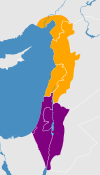Cilician Arabic: Difference between revisions
Tags: Mobile edit Mobile app edit Android app edit |
No edit summary |
||
| (5 intermediate revisions by 2 users not shown) | |||
| Line 19: | Line 19: | ||
}} |
}} |
||
'''Cilician Arabic''', '''Cilicia-Antioch Arabic''', '''Çukurova Arabic''', or '''Çukurovan''' is a [[Levantine Arabic|Levantine dialect]] spoken in Turkey |
'''Cilician Arabic''', '''Cilicia-Antioch Arabic''', '''Çukurova Arabic''', or '''Çukurovan''' is a [[Levantine Arabic|Levantine dialect]] spoken in Turkey in the geo-cultural area of [[Cilicia]], the coastal region of the Turkish [[Eastern Mediterranean]] from [[Hatay Province|Hatay]] to [[Mersin Province|Mersin]] and [[Adana Province|Adana]].<ref>{{cite book|chapter-url=https://www.academia.edu/3857818|last1=Procházka-Eisl|first1=Gisela|last2=Procházka|first2=Stephan|date=2018|publisher=Harrassowitz Verlag|editor1-last=Bulut|editor1-first=Christiane|page=309-328|title=Linguistic minorities in Turkey and Turkic-speaking minorities of the periphery|chapter=The Arabic speaking Alawis of the Çukurova: The transformation of a linguistic into a purely religious minority|access-date=2020-06-28}}</ref><ref>{{cite web|url=https://www.academia.edu/6509784|title=Anatolian Arabic|work=Academia.edu|access-date=2020-06-28}}</ref> |
||
== Speakers == |
== Speakers == |
||
Cilician Arabic speakers in Turkey come from four different religious groups: [[Sunni Islam|Sunni Muslims]], [[Alawites]], [[Antiochian Greek Christians|Christians]] (including [[Greek Orthodox Church|Greek Orthodox]] and [[Catholicism|Catholics]]), and [[History of the Jews in Turkey|Jews]]. It is difficult to know the number speakers. Due to pressures against [[minority language]]s, younger generations of the Arabic-speaking communities increasingly use Turkish as their mother tongue. In 1971, 36% of the population in Hatay was Arabic-speaking. In 1996, Grimes estimated 500,000 speakers of North Levantine Arabic in Turkey.<ref name="Turkey EALL">{{cite book |first1=Joan |last1=Smith-Kocamahhul |chapter=Turkey |title=Encyclopedia of Arabic Language and Linguistics |editor1-first=Lutz |editor1-last=Edzard |editor2-first=Rudolf |editor2-last=de Jong |doi=10.1163/1570-6699_eall_EALL_COM_0357 }}</ref> |
|||
In 2011, according to Procházka there were 70,000 Çukurova Arabic speakers in the [[Adana Province|Adana]] and [[Mersin Province|Mersin]] provinces and people under 30 years old had completely switched to Turkish.<ref name="Cilician EALL">{{cite book |first1=Stephan |last1=Procházka |chapter=Cilician Arabic |title=Encyclopedia of Arabic Language and Linguistics |editor1-first=Lutz |editor1-last=Edzard |editor2-first=Rudolf |editor2-last=de Jong |doi=10.1163/1570-6699_eall_EALL_COM_0056 }}</ref> In 2011, Werner estimated 200,000 Antiochia Arabic speakers in [[Hatay Province|Hatay]].<ref name="EALL Antiochia Arabic">{{cite book |first1=Werner |last1=Arnold |chapter=Antiochia Arabic |title=Encyclopedia of Arabic Language and Linguistics |editor1-first=Lutz |editor1-last=Edzard |editor2-first=Rudolf |editor2-last=de Jong |doi=10.1163/1570-6699_eall_EALL_COM_0018 }}</ref> According to Ethnologue, |
In 2011, according to Procházka there were 70,000 Çukurova Arabic speakers in the [[Adana Province|Adana]] and [[Mersin Province|Mersin]] provinces and people under 30 years old had completely switched to Turkish.<ref name="Cilician EALL">{{cite book |first1=Stephan |last1=Procházka |chapter=Cilician Arabic |title=Encyclopedia of Arabic Language and Linguistics |editor1-first=Lutz |editor1-last=Edzard |editor2-first=Rudolf |editor2-last=de Jong |doi=10.1163/1570-6699_eall_EALL_COM_0056 }}</ref> In 2011, Werner estimated 200,000 Antiochia Arabic speakers in [[Hatay Province|Hatay]].<ref name="EALL Antiochia Arabic">{{cite book |first1=Werner |last1=Arnold |chapter=Antiochia Arabic |title=Encyclopedia of Arabic Language and Linguistics |editor1-first=Lutz |editor1-last=Edzard |editor2-first=Rudolf |editor2-last=de Jong |doi=10.1163/1570-6699_eall_EALL_COM_0018 }}</ref> According to Ethnologue, the language is "threatened" in Turkey.<ref>{{Cite web|title=Turkey|url=https://www.ethnologue.com/country/TR/languages|access-date=2021-10-08|website=Ethnologue|language=en}}</ref> Çukurova Arabic is in danger of becoming [[Extinct language|extinct]] in a few decades.<ref name="Cilician EALL"/> |
||
==References== |
==References== |
||
Latest revision as of 03:34, 4 February 2024
| Cilician Arabic | |
|---|---|
| Native to | Turkey |
| Arabic alphabet | |
| Language codes | |
| ISO 639-3 | (covered by apc) |
| Glottolog | cili1234 |
| IETF | apc-TR |
Cilician Arabic, Cilicia-Antioch Arabic, Çukurova Arabic, or Çukurovan is a Levantine dialect spoken in Turkey in the geo-cultural area of Cilicia, the coastal region of the Turkish Eastern Mediterranean from Hatay to Mersin and Adana.[1][2]
Speakers[edit]
Cilician Arabic speakers in Turkey come from four different religious groups: Sunni Muslims, Alawites, Christians (including Greek Orthodox and Catholics), and Jews. It is difficult to know the number speakers. Due to pressures against minority languages, younger generations of the Arabic-speaking communities increasingly use Turkish as their mother tongue. In 1971, 36% of the population in Hatay was Arabic-speaking. In 1996, Grimes estimated 500,000 speakers of North Levantine Arabic in Turkey.[3]
In 2011, according to Procházka there were 70,000 Çukurova Arabic speakers in the Adana and Mersin provinces and people under 30 years old had completely switched to Turkish.[4] In 2011, Werner estimated 200,000 Antiochia Arabic speakers in Hatay.[5] According to Ethnologue, the language is "threatened" in Turkey.[6] Çukurova Arabic is in danger of becoming extinct in a few decades.[4]
References[edit]
- ^ Procházka-Eisl, Gisela; Procházka, Stephan (2018). "The Arabic speaking Alawis of the Çukurova: The transformation of a linguistic into a purely religious minority". In Bulut, Christiane (ed.). Linguistic minorities in Turkey and Turkic-speaking minorities of the periphery. Harrassowitz Verlag. p. 309-328. Retrieved 2020-06-28.
- ^ "Anatolian Arabic". Academia.edu. Retrieved 2020-06-28.
- ^ Smith-Kocamahhul, Joan. "Turkey". In Edzard, Lutz; de Jong, Rudolf (eds.). Encyclopedia of Arabic Language and Linguistics. doi:10.1163/1570-6699_eall_EALL_COM_0357.
- ^ a b Procházka, Stephan. "Cilician Arabic". In Edzard, Lutz; de Jong, Rudolf (eds.). Encyclopedia of Arabic Language and Linguistics. doi:10.1163/1570-6699_eall_EALL_COM_0056.
- ^ Arnold, Werner. "Antiochia Arabic". In Edzard, Lutz; de Jong, Rudolf (eds.). Encyclopedia of Arabic Language and Linguistics. doi:10.1163/1570-6699_eall_EALL_COM_0018.
- ^ "Turkey". Ethnologue. Retrieved 2021-10-08.

